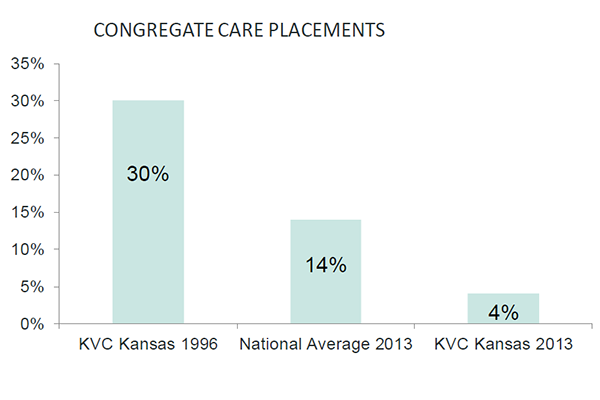Children Grow Best In Families: Moving from Congregate Care to Community-Based Care

KVC started as a group home for adolescent boys in 1970. In 1980, Wayne Sims joined KVC as President and CEO, and saw that residential group home care was not the ideal living situation for most children. Kids were being sent to facilities out of state, families had no means of visiting them, and the state had no resources to support families visiting their children out of state. Sims’ vision was to create a broad community-based continuum of care to help children and families wherever they were, whatever their needs.
Watch this video to learn more:
When KVC started providing foster care case management services in Kansas in 1996, 30% of children in state custody were living in congregate care such as group homes. By 2002, that number had dropped to 9%, and by 2013, less than 4% of Kansas children served by KVC were living in congregate care; which is much better than the national average of 14%. For many years now, KVC Kansas has kept that rate at or near 4%, and of those few children that do live in a congregate/residential care setting, most are there for the specific purpose of receiving acute psychiatric treatment.
Over the years, our foster family care and in-home therapy services have grown significantly. We believe children grow best in families, and there is significant research to support this:
- Youth placed in congregate care are less likely to find permanent homes than those who live in family settings.
- Youth who live in institutional settings are at greater risk of developing physical, emotional and behavioral problems.
- Current law requires that children be placed in the least restrictive setting possible while maintaining the child’s safety and health.
- Congregate placements cost child welfare systems three to five times the amount of family-based placements, and often result in poorer outcomes.
Right-sizing congregate care is necessary to help children find permanent homes faster and free up funds to support the development of needed community-based services. KVC has recognized the need to provide residential services as a treatment type, not as a living situation for children. As a result, Kansas was the first state to successfully exit a Children’s Rights Settlement Agreement by showing significant, measurable improvement in over 100 identified areas.
A large number of states have reduced their reliance on placing children in state custody in congregate care, and increased their efforts on community-based care for children. According to a report in My Record Journal, Connecticut saved $50 million in the last five years by focusing on placing children with foster/adoptive families rather than in group homes.
Due to our use of evidence-based practices to achieve strong outcomes, The Annie E. Casey Foundation has made KVC part of its Provider Exchange. This is a group of dynamic, successful child welfare providers on a mission to deliver individualized support so child welfare providers can meet their particular programmatic, operational or fiscal challenges and improve the lives of kids and families.
Our success has helped KVC grow into multiple U.S. states and even into international territory through consulting. The country of Singapore in Southeast Asia turned to our organization to learn how to make the transition from congregate care to community-based care. Sims presented at the Singapore Ministry of Social and Family Development’s conference in October 2014.
If your agency is interested in right-sizing congregate care or other child welfare best practices, learn more about our consulting services.






